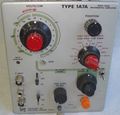1A7A: Difference between revisions
No edit summary |
No edit summary |
||
| (7 intermediate revisions by 2 users not shown) | |||
| Line 8: | Line 8: | ||
|introduced=1968 | |introduced=1968 | ||
|discontinued=1975 | |discontinued=1975 | ||
|designers=Thor Hallen | |designers=Thor Hallen, Val Garuts | ||
|manuals= | |manuals= | ||
* [[Media:070-0782-00.pdf|Tektronix 1A7A Manual]] | * [[Media:070-0782-00.pdf|Tektronix 1A7A Manual]] | ||
| Line 14: | Line 14: | ||
* [[Media:Tek 1a7a fcp april 1968.pdf|Tektronix 1A7A Factory Calibration Procedure, April 1968]] | * [[Media:Tek 1a7a fcp april 1968.pdf|Tektronix 1A7A Factory Calibration Procedure, April 1968]] | ||
}} | }} | ||
The '''Tektronix 1A7A''', designed by [[Thor Hallen]] and [[introduced in 1968]], is a redesign of the [[1A7]] high-sensitivity differential plug-in for [[500-series scopes]]. | The '''Tektronix 1A7A''', nominally designed by [[Thor Hallen]] and [[introduced in 1968]], is a redesign of the [[1A7]] high-sensitivity differential amplifier plug-in for [[500-series scopes]]. | ||
The [[1A7]] and [[1A7A]] have essentially the same features including 10 μV/Div deflection factor when either AC or DC-coupled, high and low frequency bandwidth limit filters, DC Offset, high common mode rejection ratio and large common mode dynamic range. | |||
The 1A7A doubled the 1A7's bandwidth (to 1 MHz) | The 1A7A doubled the 1A7's bandwidth (to 1 MHz) and has a JFET input stage that greatly reduced input drift. | ||
The 1A7A's differential amplifier design was re-used with some modifications | The 1A7A's differential amplifier design was re-used with some modifications | ||
in the [[3A9]], [[3A10]], [[7A22]], [[5A22N]] and [[5030]]/[[5031]] scopes. The [[AM502]] and [[26A2]] use BJTs instead of JFETs for the offset current sources. | in the [[3A9]], [[3A10]], [[7A22]], [[5A22N]] and [[5030]]/[[5031]] scopes. The [[AM502]] and [[26A2]] use BJTs instead of JFETs for the differential offset current sources. | ||
Type 1A7A remained available until the end of the [[500-series scopes|500-series]] line. | Type 1A7A remained available until the end of the [[500-series scopes|500-series]] line. | ||
| Line 27: | Line 27: | ||
[[John Addis]] [[Preamble DA1855|says]]: | [[John Addis]] [[Preamble DA1855|says]]: | ||
The 1A7A (designed by Thor Hallen) and the [[7A22]] (designed by [[Val Garuts]]) used essentially the same circuit. | The 1A7A (designed by Thor Hallen) and the [[7A22]] (designed solely by [[Val Garuts]]) used essentially the same circuit. The brilliant input circuit was the work of [[Val Garuts]]. The 1A7A came out first. Most of the others were introduced the following year (1969). Thor had worked at Tektronix for [[Val Garuts]] less than a year when the 1A7A was introduced. Thor later became famous for designing not just the [[7904]] (500 MHz mainframe) but also its [[7A19]] plugin. Thor died in 2002. | ||
</blockquote> | </blockquote> | ||
{{BeginSpecs}} | {{BeginSpecs}} | ||
Latest revision as of 20:15, 3 July 2024
The Tektronix 1A7A, nominally designed by Thor Hallen and introduced in 1968, is a redesign of the 1A7 high-sensitivity differential amplifier plug-in for 500-series scopes. The 1A7 and 1A7A have essentially the same features including 10 μV/Div deflection factor when either AC or DC-coupled, high and low frequency bandwidth limit filters, DC Offset, high common mode rejection ratio and large common mode dynamic range.
The 1A7A doubled the 1A7's bandwidth (to 1 MHz) and has a JFET input stage that greatly reduced input drift.
The 1A7A's differential amplifier design was re-used with some modifications in the 3A9, 3A10, 7A22, 5A22N and 5030/5031 scopes. The AM502 and 26A2 use BJTs instead of JFETs for the differential offset current sources.
Type 1A7A remained available until the end of the 500-series line.
The 1A7A (designed by Thor Hallen) and the 7A22 (designed solely by Val Garuts) used essentially the same circuit. The brilliant input circuit was the work of Val Garuts. The 1A7A came out first. Most of the others were introduced the following year (1969). Thor had worked at Tektronix for Val Garuts less than a year when the 1A7A was introduced. Thor later became famous for designing not just the 7904 (500 MHz mainframe) but also its 7A19 plugin. Thor died in 2002.
Key Specifications
| Deflection | 10 μV/Div to 10 V/Div in 1–2–5 sequence |
|---|---|
| Input impedance | 1 MΩ // 47 pF (either input) |
| Bandwidth | 1 MHz, LF limit switchable DC, 0.1 Hz to 10 kHz in ×10 steps, HF limit switchable 100 Hz to 1 MHz in ×3/×10 steps, AC coupling 1.6 Hz |
| Signal ranges |
| Range | Differential signal | DC Offset | Common mode |
|---|---|---|---|
| 10 μV/Div to 10 mV/Div | ±0.4 V | ±0.4 V | ±10 V |
| 20 mV/Div to 0.1 V/Div | ±4 V | ±4 V | ±100 V |
| 0.2 V/Div to 1 V/Div | ±40 V | ±40 V | ±500 V |
| 2 V/Div to 10 V/Div | ±400 V | ±400 V | ±500 V |
Pictures
Components
Some Parts Used in the 1A7A
- (no results)












